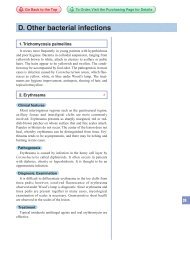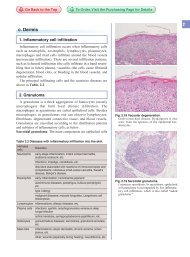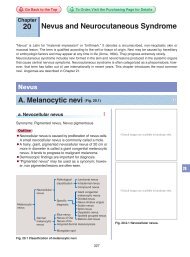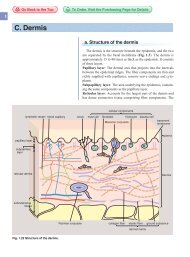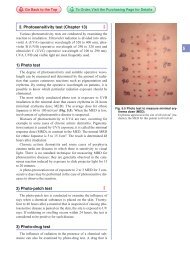2. Vitiligo vulgaris
2. Vitiligo vulgaris
2. Vitiligo vulgaris
Create successful ePaper yourself
Turn your PDF publications into a flip-book with our unique Google optimized e-Paper software.
surgical intervention (Fig. 16.6) and narrowband UVB exposure<br />
are also conducted.<br />
3. Piebaldism<br />
Synonym: Partial albinism<br />
A. Diseases of depigmentation 263<br />
Definition<br />
Piebaldism is characterized by localized leukoderma with<br />
leukotrichia on the forehead and frontal region of the head. Few<br />
melanocytes are found around the areas of aleukoderma b and c whited<br />
e f g h i j k l<br />
hair; albinism develops locally. A congenital, autosomal domi- Fig. 16.5-2 <strong>Vitiligo</strong> <strong>vulgaris</strong> on various sites.<br />
nant disease, it occurs with a frequency of 1 in 200,000.<br />
e: On the forehead.<br />
Clinical features<br />
Triangular or diamond-shaped leukotrichia and leukoderma<br />
are seen on the forehead and frontal region of the head (white<br />
forelock) at the time of birth. These do not enlarge or shrink with<br />
age. Contralateral geographic vitiligo occurs on the extremities<br />
and trunk. Small pigmented patches often occur within the leukoderma.<br />
Pathogenesis, Pathology<br />
Piebaldism is caused by abnormality in the c-kit gene. In fetal<br />
development, melanoblasts migrate from the neural crest to the<br />
epidermis to anchor and differentiate into melanocytes. The c-kit<br />
gene on chromosome 4 (4q12) encodes a receptor that is associated<br />
with the migration and anchoring of melanoblasts. Because<br />
piebaldism is autosomal dominant, abnormality occurs in half of<br />
each receptor, leaving an area on which melanoblasts do not<br />
anchor, and resulting in leukoderma. Histopathologically,<br />
melanocytes are lacking at the sites with leukotrichia and leukoderma.<br />
Diagnosis, Treatment<br />
Diagnosis is made by history-taking of autosomal dominant<br />
expression, and white forelock and small pigmented patches on<br />
leukoderma. Waadenburg-Klein syndrome, whose symptoms are<br />
similar to those of piebaldism, is accompanied by facial displasia<br />
and deaf-mutism. Skin graft and cultured pigmented cell transplantation<br />
have been reported to be effective.<br />
Clinical images are available in hardcopy only.<br />
a b c d e f g h<br />
Clinical images are available in hardcopy only.<br />
a b c d e f g h i<br />
Fig. 16.6 Suction blister treatment of vitiligo<br />
<strong>vulgaris</strong>.<br />
a: Vacuum aspiration is applied on normal skin<br />
to artificially produce a suction blister. b: Vacuum<br />
aspiration is applied on skin with vitiligo <strong>vulgaris</strong><br />
to produce a suction blister. The covering of<br />
the vitiligo <strong>vulgaris</strong> blister is removed and<br />
replaced with the covering of the normal skin<br />
blister.<br />
16
dizziness, and pain in the eyes for 5 to 7 days. In the eye disease<br />
stage, acute bilateral uveitis develops. Sensorineural deafness and<br />
disequilibrium frequently occur. These symptoms persist for 1 to<br />
2 months and then gradually subside. The main symptoms of the<br />
recovery stage are those of the prodrome stage and eye disease<br />
stage. Loss of uveal melanocytes results in light red color of the<br />
entire fundus oculi.<br />
Pathogenesis<br />
Vogt-Koyanagi-Harada disease is thought to be caused by<br />
allergy or viral infection. It should be grouped with autoimmune<br />
diseases because of the autoimmune reaction against<br />
melanocytes. HLA-DR4 is highly associated with the occurrence<br />
of Vogt-Koyanagi-Harada disease.<br />
Diagnosis, Differential diagnosis<br />
Diagnosis is made by the characteristic clinical features.<br />
Treatment<br />
The main treatment is systemic steroids. Steroid pulse therapies<br />
(1,000 mg methylprednisolone administered intravenously<br />
for 3 consecutive days) and immunosuppressants (e.g.,<br />
cyclosporine) are also used for eye involvement. Steroids and<br />
PUVA therapies are applied to the cutaneous lesions.<br />
6. Senile leukoderma<br />
Sharply circumscribed, round or irregular-shaped leukoderma<br />
of 4 mm to 10 mm in diameter appear diffusely on the trunk and<br />
extremities of men and women in their 30s, increasing in number<br />
with age. Senile leukoderma is essentially identified with idiopathic<br />
guttate hypomelanosis. Pathological findings show a<br />
reduction in the number of activated melanocytes and<br />
melanosomes and dysfunction in melanocytes and melanosomes<br />
from melanocytic senescence.<br />
7. Nevus depigmentosus<br />
Nevus depigmentosus is a common nevoid abnormality present<br />
in about 1 in 125 neonates. Because of the congenital<br />
melanocytic dysfunction in skin, incomplete hypopigmented<br />
patches are seen at birth or shortly thereafter (Fig. 16.9). The<br />
patches vary in shape and distribution from solitary and irregular<br />
to multiple and band-like. Size, distribution and number of nevus<br />
depigmentosus patches remain the same over the course of a lifetime.<br />
8. Leukoderma pseudosyphiliticum<br />
Leukoderma pseudosyphiliticum most commonly occurs on<br />
the lumbar regions and buttocks of men in their 20s and 30s<br />
A. Diseases of depigmentation 265<br />
Clinical images are available in hardcopy only.<br />
Fig. 16.8 Vogt-Koyanagi-Harada disease.<br />
Irregularly shaped leukoderma is sporadically<br />
seen.<br />
Clinical images are available in hardcopy only.<br />
Clinical images are available in hardcopy only.<br />
Fig. 16.9 Nevus depigmentosus.<br />
16
16<br />
266 16 Disorders of Skin Color<br />
B. Disorders of hyperpigmentation<br />
Clinical images are available in hardcopy only.<br />
Clinical images are available in hardcopy only.<br />
Fig. 16.10 Ephelides.<br />
whose skin is naturally dark, in Asians in particular. Multiple,<br />
sharply circumscribed, incomplete hypopigmented patches of 1<br />
cm to 2 cm in diameter occur, often coalescing to become reticular.<br />
It is asymptomatic. The reticular leukoderma resembles<br />
syphilitic leukoderma; nevertheless, the two can be differentiated:<br />
Syphilitic leukoderma tends to occur on exposed sites, and<br />
the standard serologic test for syphilis is positive.<br />
1. Ephelides<br />
Clinical features<br />
Multiple round smooth-surfaced brown patches about 3 mm in<br />
diameter occur on the sun-exposed areas of the face, neck and<br />
forearms (Fig. 16.10). Ephelides darkens with sun exposure<br />
(especially exposure to UVR) in summer and tends to fade in<br />
winter. It worsens with age and is most remarkable at puberty; it<br />
lightens thereafter.<br />
Pathogenesis, Pathology<br />
Ephelides tends to run in families; it is thought to be autosomal<br />
dominant. However, it can be autosomal recessive in severe<br />
cases. Melanocytes are activated by hereditary factors, and<br />
melanosomes markedly increase in the basal keratinocytes.<br />
Melanocytes in patients with ephelides have well-developed dendritic<br />
spines and enhanced functions; however, the number of<br />
melanocytes does not change.<br />
Diagnosis, Treatment<br />
Differentiation from lentigo, Peutz-Jeghers syndrome, xeroderma<br />
pigmentosum, and progeria is necessary. Sunscreen is useful<br />
for blocking UVR.<br />
<strong>2.</strong> Melasma<br />
Synonym: Chloasma<br />
Clinical features<br />
Melasma tends to occur in women in their 30s or older. It is<br />
rare in men. Sharply demarcated light brown patches occur on<br />
the face (forehead, cheeks, and around the mouth, in particular),<br />
usually symmetrically. Melasma patches are irregular in size and<br />
shape. The disorder is aggravated by UVR in summer, and it subsides<br />
in winter (Fig. 16.11). Pregnancy may trigger the onset<br />
(chloasma gravidarum).<br />
Go Back to the Top To Order, Visit the Purchasing Page for Details




